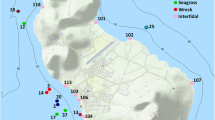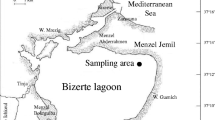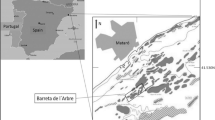Abstract
The structural complexity of algae is an important factor driving the structure of epifaunal assemblages associated with marine macroalgae. We tested how the structural complexity of four Sargassum species is related to the structure of gammarid assemblages. We measured different algae traits (frond length, number of branches, and epiphytic hydroid and algae cover) and different ecological descriptors of gammarid assemblages (richness, density, diversity, and evenness). Samples were obtained in southeastern Brazil in early and late summer. Structural complexity was associated with the occurrence of significantly different gammarid assemblages. Sargassum cymosum had more branches and greater hydroid coverage, and a higher gammarid species richness, diversity, and density. The characteristics of the gammarids inhabiting the different Sargassum species were similar between sampling periods, indicating that the relationships between the Sargassum traits and associated gammarids are strong and persistent. Species richness, diversity, and density were all more dependent on habitat heterogeneity (number of branches and coverage of epiphytic hydroid) than the quantity of habitable space, i.e., frond length. Overall, the variation in structural complexity among Sargassum species had a significant effect on gammarid assemblage structure.


Similar content being viewed by others
References
Alarcón-Ortega, L. C., J. M. Guerra-García, J. E. Sánchez-Moyano & F. Cuoul-Magaña, 2012. Feeding habits of caprellids (Crustacea: Amphipoda) from the west coast of Mexico. Do they feed on their hosting substrates? Zoologica Baetica 23: 11–20.
Amsler, C., 2008. Algal Chemical Ecology. Springer, Berlin: 468.
Anderson, M. J., 2000. DISTLM: a FORTRAN computer program to calculate a distance-based multivariate analysis for a linear model. Department of Statistics, University of Auckland, Auckland.
Anderson, M. J. & T. J. Willis, 2003. Canonical analysis of principal coordinates: a useful method of constrained ordination for ecology. Ecology 84: 511–525.
Anderson, M. J., R. N. Gorley & K. R. Clarke, 2008. PERMANOVA+. Guide to Software and Statistical Methods. PRIMER-E, Plymouth.
Attrill, M. J., J. A. Strong & A. A. Rowden, 2000. Are macroinvertebrate communities influenced by seagrass structural complexity? Ecography 23: 114–121.
Bavestrello, G., C. Cerrano, R. Cattaneo-Vietti & M. Sarà, 1996. Relations between Eudendrium glomeratum (Cnidaria, Hydromedusae) and its associated vagile fauna. Scientia Marina 60: 137–143.
Berchez, F. A., R. T. Pereira & N. F. Kamiya, 1993. Culture of Hypnea musciformis (Rhodophyta, Gigartinales) on artificial substrates attached to linear ropes. Hydrobiologia 260: 415–420.
Bradshaw, C., P. Collins & A. R. Brand, 2003. To what extent does upright sessile epifauna affect benthic biodiversity and community composition? Marine Biology 143: 783–791.
Breitburg, D. L., 1985. Development of a subtidal epibenthic community: factors affecting species composition and the mechanisms of succession. Oecologia 65: 173–184.
Buschbaum, C., A. S. Chapman & B. Saier, 2006. How an introduced seaweed can affect epibiota diversity in different coastal systems. Marine Biology 148: 743–754.
Buschmann, A. H. & P. Gómez, 1993. Interaction mechanisms between Gracilaria chilensis (Rhodophyta) and epiphytes. Hydrobiologia 260: 345–351.
Chemello, R. & M. Milazzo, 2002. Effect of algal architecture on associated fauna: some evidence from phytal molluscs. Marine Biology 140: 981–990.
Christie, H., K. M. Norderhaug & S. Fredriksen, 2009. Macrophytes as habitat for fauna. Marine Ecology Progress Series 396: 221–233.
Conlan, K. E., 1982. Revision of the gammaridean amphipod family Ampithoidae using numerical analytical methods. Canadian Journal of Zoology 60: 2015–2027.
Cunha, A. F. & G. B. Jacobucci, 2010. Seasonal variation of epiphytic hydroids (Cnidaria: Hydrozoa) associated to a subtropical Sargassum cymosum (Phaeophyta: Fucales) bed. Zoologia (Curitiba) 27: 945–955.
Cunha, F. L. R., A. F. Cunha & G. B. Jacobucci, 2009. Is the occurrence of caprellid amphipods associated with Sargassum (Phaeophyta) influenced by algal and hydrozoan epibiosis? Revista Brasileira de Zoociências 10: 257–264.
Davenport, J. P., J. A. Pugh & J. McKechnie, 1996. Mixed fractals and anisotropy in subantarctic marine macroalgae from South Georgia: implications for epifaunal biomass and abundance. Marine Ecology Progress Series 136: 245–255.
Denadai, M. R., A. C. Z. Amaral & A. Turra, 2005. Structure of molluscan assemblages in sheltered intertidal unconsolidated environments. Brazilian Archives of Biology and Technology 48: 825–839.
Di Camillo, C. G., G. Bavestrello, L. Valisano & S. Puce, 2008. Spatial and temporal distribution in a tropical hydroid assemblage. Journal of the Marine Biological Association of the United Kingdom 88: 1589–1599.
Downes, B. J., P. S. Lake, E. S. G. Schreiber & A. Glaister, 2000. Habitat structure, resources and diversity: the separate effects of surface roughness and macroalgae on stream invertebrates. Oecologia 123: 569–581.
Dubiaski-Silva, J. & S. Masunari, 1995. Population ecology of Amphipoda (Crustacea) from the phytals of Caiobá, Matinhos, Paraná, Brazil. Revista Brasileira de Zoologia 12: 373–396.
Duffy, J. E., 1990. Amphipods on seaweeds: partners or pests? Oecologia 83: 267–276.
Ebbs, N., 1966. The coral-inhabiting polychaetes of the Northern Florida reef tract, part 1. Bulletin of Marine Science 16: 485–555.
Edgar, G. J. & A. I. Robertson, 1992. The influence of seagrass structure on the distribution and abundance of motile epifauna: pattern and process in a western Australian Amphibolis bed. Journal of Experimental Marine Biology and Ecology 160: 13–31.
Fenwick, G. D., 1976. The effect of wave exposure on the amphipod fauna of the alga Caulerpa brownii. Journal of Experimental Marine Biology and Ecology 3: 1–43.
Graham, N. A. J. & K. L. Nash, 2013. The importance of structural complexity in coral reef ecosystems. Coral Reefs 32: 315–326.
Groemping, U., 2006. Relative importance for linear regression in R: the package relaimpo. Journal of Statistical Software 17: 1–27.
Guerra-García, J. M., J. T. Figueroa, C. Navarro-Barranco, M. Ros, J. E. Sánchez-Moyano & J. Moreira, 2014. Dietary analysis of the marine Amphipoda (Crustacea: Peracarida) from the Iberian Peninsula. Journal of Sea Research 85: 508–517.
Hacker, S. D. & R. S. Steneck, 1990. Habitat architecture and the abundance and body-size dependent habitat selection of a phytal amphipod. Ecology 71: 2269–2285.
Harari, J. & A. R. Mesquita, 2007. Tábua de marés para Ubatuba, Santos e Cananéia. Relatório Técnico do Instituto Oceanográfico 81: 1–17.
Heck Jr., K. L. & G. S. Wetstone, 1977. Habitat complexity and invertebrate species richness and abundance in tropical seagrass meadows. Journal of Biogeography 1: 135–142.
Hutchinson, G. E., 1957. Population studies, animal ecology and demography, concluding remarks. Cold Spring Harbor Symposia on Quantitative Biology 22: 415–427.
Hutchinson, G. E., 1959. Homage to Santa Rosalia or why are there so many kinds of animals? The American Naturalist 93: 145–159.
Jacobucci, G. B. & F. P. P. Leite, 2002. Distribuição vertical e flutuação sazonal da macrofauna vágil associada a Sargassum cymosum C. Agardh, na praia do Lázaro, Ubatuba, São Paulo, Brasil. Revista Brasileira de Zoologia 19: 87–100.
Jacobucci, G. B. & F. P. P. Leite, 2014. The role of epiphytic algae and different species of Sargassum in the distribution and feeding of herbivorous amphipods. Latin American Journal Aquatic Research 42: 353–363.
James, P. L. & K. L. Heck, 1994. The effects of habitat complexity and light intensity on ambush predation within a simulated seagrass habitat. Journal of Experimental Marine Biology and Ecology 176: 187–200.
Leite, F. P. P., M. O. Tanaka & R. S. Gebara, 2007a. Structural variation in the brown alga Sargassum cymosum and its effects on associated amphipod assemblages. Brazilian Journal of Biology 67: 215–221.
Leite, F. P. P., M. O. Tanaka, D. B. Sudatti & R. S. Gebara, 2007b. Diel density variation of amphipods associated with Sargassum beds from two shores of Ubatuba, Southeastern, Brasil. Iheringia. Série Zoologia 97: 400–405.
Little, C., G. A. William & D. Trowbridge, 2015. The Biology of Rocky Shores. Oxford University Press, Oxford.
Machado, G. B. D. O., A. B. Neufeld, S. A. Dena, S. G. L. Siqueira & F. P. P. Leite, 2015. Variation of amphipod assemblage along the Sargassum stenophyllum (Phaeophyta, Fucales) thallus. Nauplius 23: 73–78.
MacLeod, P. & I. Valiela, 1975. The effect of density and mutual interference by a Predator: a laboratory study of predation by the Nudibranch Coryphella rufibranchialis on the hydroid Tubularia larynx. Hydrobiologia 47: 339–346.
Mahiques, M. M., G. Tessler & V. V. Furtado, 1998. Characterization of energy gradient in enclosed bays of Ubatuba region, South-eastern Brazil. Estuarine Coastal and Shelf Science 47: 431–446.
Martin-Smith, K. M., 1993. Abundance of mobile epifauna: the role of habitat complexity and predation by fishes. Journal of Experimental Marine Biology and Ecology 174: 243–260.
Montouchet, P. G. C., 1979. Sur la communauté des animaux vagiles associés à Sargassum cymosum C. Agardh, à Ubatuba, Etat de São Paulo Brésil. Studies on Neotropical Fauna and Environment 18: 151–161.
Nakamura, Y., M. Horinouchi, T. Nakai & M. Sano, 2003. Food habits of fishes in a seagrass bed on a fringing coral reef at Iriomote Island, southern Japan. Ichthyological Research 50: 15–22.
Nelson, W. G., 1979. Experimental studies of selective predation on amphipods: consequences for amphipod distribution and abundance. Journal of Experimental Marine Biology and Ecology 38: 225–245.
Paradis, E., J. Claude & K. Strimmer, 2004. APE: analyses of phylogenetics and evolution in R language. Bioinformatics 20: 289–290.
Paula, E. J., 1988. O gênero Sargassum C. Ag. (Phaeophyta-Fucales) no litoral do Estado de São Paulo, Brasil. Boletim de Botânica da Universidade de São Paulo 10: 65–118.
Poore, A. G., A. H. Campbell, R. A. Coleman, G. J. Edgar, V. Jormalainen, P. L. Reynolds, E. E. Sotka, J. J. Stachowicz, R. B. Taylor, M. A. Vanderklift & J. E. Duffy, 2012. Global patterns in the impact of marine herbivores on benthic primary producers. Ecology Letters 15: 912–922.
Reis, R. P., M. C. R. Leal, Y. Yoneshigue-Valentin & F. Belluco, 2003. Efeito de fatores bióticos no crescimento de Hypnea musciformis (Rhodophyta-Gigartinales). Acta Botanica Brasilica 17: 279–286.
Ronowicz, M., M. Wlodarska-Kowalczuk & P. Kuklinski, 2008. Factors influencing hydroids (Cnidaria: Hydrozoa) biodiversity and distribution in Arctic kelp forest. Journal of the Marine Biological Association of the United Kingdom 88: 1567–1575.
Rosenzweig, M. L., 1995. Species diversity in space and time. Cambridge University Press, Cambridge.
RStudio, 2018. RStudio: integrated development environment for R (Version 1.1.442) [Computer software]. Boston, MA. Retrieved May 20, 2012. [available on internet at http://www.rstudio.org/]
Russell, D. J. & J. W. Hedgpeth, 1990. Host utilization during ontogeny by two pycnogonid species (Tanystylum duospinum and Ammothea hilgendorfi) parasitic on the hydroid Eucopella everta (Coelenterata:Campanulariidae). Bijdragen tot de Dierkunde 60: 215–224.
Russo, A. R., 1990. The role of seaweed complexity in structuring Hawaiian epiphytal amphipod communities. Hydrobiologia 194: 1–12.
Schreider, M. J., T. M. Glasby & A. J. Underwood, 2003. Effects of height on the shore and complexity of habitat on abundances of amphipods on rocky shores in New South Wales, Australia. Journal of Experimental Marine Biology and Ecology 293: 57–71.
Serejo, C. S., 2004. Cladistic revision of talitroidean amphipods (Crustacea, Gammaridea), with a proposal of a new classification. Zoologica Scripta 33: 551–586.
Staples, D. A. & J. E. Watson, 1987. Associations between pycnogonids and hydroids. In Bouillon, J., F. Boero, F. Cicogna & P. F. S. Cornelius (eds), Modern Trends in the Systematics, Ecology and Evolution of Hydroids and Hydromedusae. Oxford University Press, Oxford: 215–226.
Stein, A., K. Gerstner & H. Kreft, 2014. Environmental heterogeneity as a universal driver of species richness across taxa, biomes and spatial scales. Ecology Letters 17: 866–880.
Széchy, M. T. M. & E. J. Paula, 2000. Padrões estruturais quantitativos em bancos de Sargassum (Phaeophyta-Fucales) do litoral dos estados do Rio de Janeiro e São Paulo, Brasil. Revista Brasileira de Botânica 23: 121–132.
Széchy, M. T. M., V. G. Veloso & E. J. Paula, 2001. Brachyura (Decapoda, Crustacea) of phytobenthic communities of the sublittoral region of rocky shores of Rio de Janeiro and São Paulo, Brazil. Tropical Ecology 42: 231–242.
Tanaka, M. O. & F. P. P. Leite, 2004. Distance effects on short-term recolonization of Sargassum stenophyllum by mobile epifauna, with an analysis of gammarid life habits. Journal of the Marine Biological Association of the United Kingdom 84: 901–910.
Tararam, A. S. & Y. Wakabara, 1981. The mobile fauna-especially Gammaridea of Sargassum cymosum. Marine Ecology Progress Series 5: 157–163.
Taylor, R. B. & R. G. Cole, 1994. Mobile epifauna on subtidal brown sea-weeds in northeastern New Zealand. Marine Ecology Progress Series 115: 271.
Torres, A. C., P. Veiga, M. Rubal & I. Sousa-Pinto, 2015. The role of annual macroalgal morphology in driving its epifaunal assemblages. Journal of Experimental Marine Biology and Ecology 464: 96–106.
Veiga, P., M. Rubal & I. Sousa-Pinto, 2014. Structural complexity of macroalgae influences epifaunal assemblages associated with native and invasive species. Marine Environmental Research 101: 115–123.
Viejo, R. M., 1999. Mobile epifauna inhabiting the invasive Sargassum muticum and two local seaweeds in northern Spain. Aquatic Botany 64: 131–149.
Wikstrom, S. A. & L. Kautsky, 2004. Invasion of a habitat-forming seaweed: effects on associated biota. Biological Invasions 6: 141–150.
Acknowledgements
The authors would like to thank Leyton Tierney and Terence A. Palmer for the English revision of the manuscript and to the anonymous reviewers for valuable and indispensable guidelines.
Author information
Authors and Affiliations
Corresponding author
Additional information
Handling editor: Luis Mauricio Bini
Electronic supplementary material
Below is the link to the electronic supplementary material.
Rights and permissions
About this article
Cite this article
Carvalho, N.F., Grande, H., Rosa Filho, J.S. et al. The structure of gammarid amphipod (Crustacea, Peracarida) assemblages associated with Sargassum (Phaeophyta, Fucales) and their link with the structural complexity of algae. Hydrobiologia 820, 245–254 (2018). https://doi.org/10.1007/s10750-018-3661-5
Received:
Revised:
Accepted:
Published:
Issue Date:
DOI: https://doi.org/10.1007/s10750-018-3661-5




